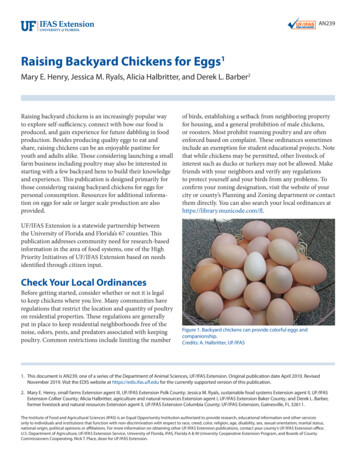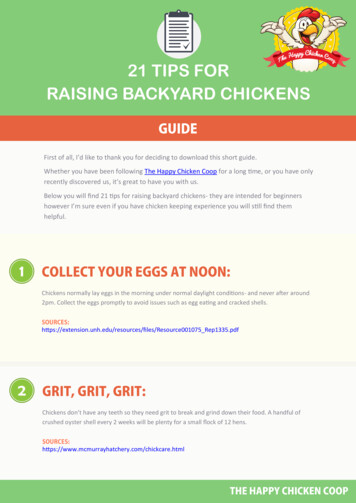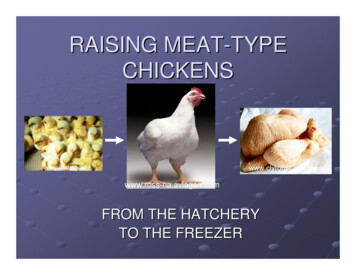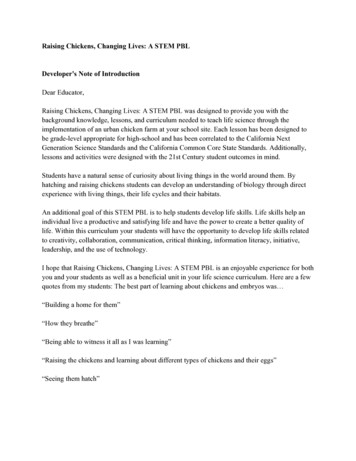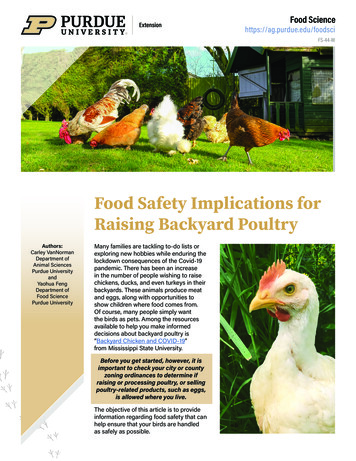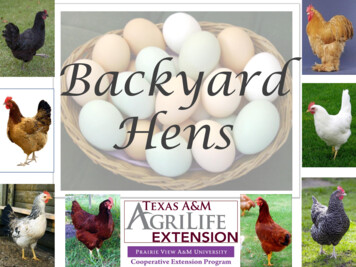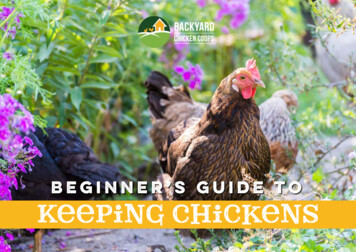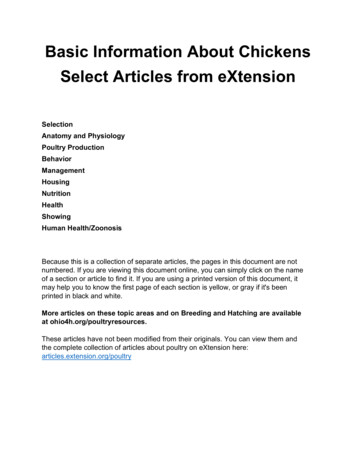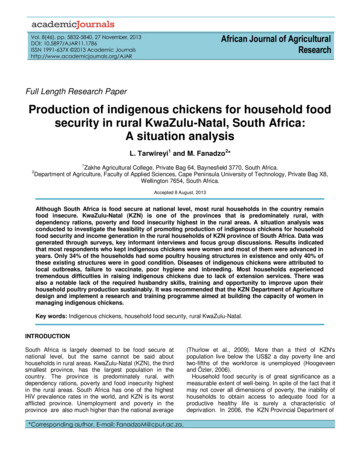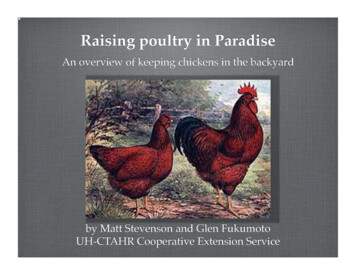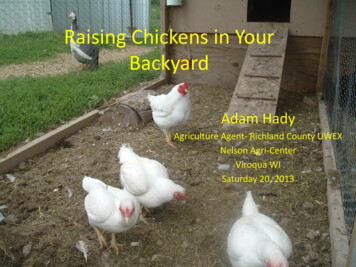
Transcription
Raising Chickens in YourBackyardAdam HadyAgriculture Agent- Richland County UWEXNelson Agri-CenterViroqua WISaturday 20, 2013
DisclaimerThis presentation containstrade names and productsfrom private companiesthese are for educationalpurposes only and are in noway an endorsement byUWEX
Topics Selection of Chickens (5-13) Housing & Equipment (14-29) Winter considerations (17-29) Starting Chicks (30-35)Poultry Nutrition Basics (36-46)Pasturing Poultry (47-59)General Poultry Health (60-70)Layers and Eggs (71-78)Meat Birds (79-82)
Benefits to raising chickens
Selecting the RightChicken for You
SO Many Where To Start American PoultryAssociationAbout 55 Breeds of StandardChickensAbout 65 Breeds of BantamChickensMany other breeds thatare not recognized
Selecting A Breed: What type of chickendo you want ?Layer typeDual PurposeMeat typeOrnamental
What size ? Standard Chickens vs Bantam ChickensBoth chickens are 2 yearold hens top is a standarddark Cornish bottom is abantam dark CornishNote: all standard chickens have a bantambut not all bantams have a standard
What Color?
What Pattern?SpangledColumbianMottledLacedBarred
Any “Funky LooK?”
What Type of Comb?PeaRoseSingleV-CombCushionButtercupStrawberry
Sources of Birds Hatcheries– Large quantities– Sell day olds– Breed type may be lacking Breeders– Breed type better– May be able to buy smaller quantities and older birds– Cost more Swaps, auctions, etc.– Inexpensive,– Purchase mature birds– Health could be an issue
Housing & Equipment
HousingKey Factors:ChickenTypesRequirementsSquare FeetLayer typePullets1.5Layer typeAdults2Broiler type2-3 Clean and dry Adequatelyventilated and draftfree Provides the properspace Provides protection
EquipmentAge(Weeks)WaterSpace (in)FeedSpace (in)0-4.2514-8.528-161316 14Feeding SystemWatering SystemLaying/Breeding/OrnamentalsNest Boxes – 1sq. ft/ 4 layersRoost – 8’’/ birdSupplemental light – 14-16 hrs.Brooding/ ChicksSupplemental Heat – 250 watt bulb/ 50chicksBrooder Guard
Birds themselvesAdjustments to feedEquipmentLitterInsulationHeatWinter slides provided by Ron Kean UWEX Poultry Specialist
Health Get rid of parasites (internal and external)May want to consider culling unthrifty,“free boarders”Age of birds Plan ahead so you don’t have late chicksVery old birds may have more problems
Feed Balanced ration should be goodExtra cracked corn or scratch grain Adds extra energy for heat Don’t overdo it Water Very importantTypically drink twice as much as feed(by weight)Need heaters or multiple trips eachday
Rubber pans (if not using heater)shilala.homestead.com
Rubber pans (if not using heater)Heater methods Base heatersLight bulb over topSubmersible cutlersupply.com
Deep litter is good (6-12 inches is good) Start it before cold sets inInsulates floorMay compost someNeed to keep it dry Keeps diseases downDecreases ammonia productionHard-packed litter loses advantagesDamp and cold are not a good combination
GOODNOT SO GOOD
Good for summer and winterWalls and ceiling if possibleInaccessible to birds Cover it with plastic, plywood, etc.Make it something they won’t eat
Balancing actwww.agcom.purdue.eduKeep heat in Move gases out Water vapor Ammonia from waste CO2 Natural ventilationWarm air rises so vents on top allow air out Cooler fresh air enters through inlets Need temperature difference (or wind) to make it work
In extreme cold Don’t want draft blowing on birds Baffle in front of inlet May want to put cloth in front of inlet Don’t want to lose too much heat
Using bird’s body heat is easiestHave a few thousand hens and this won’t be aproblem!!Try to confine birds to a small area Covered roost area “Community nest” situation Insulate this Rodents may be a problem May need to clean fairly often Use a heater
Most important is to keep itsafeKeep birds from contacting it Keep litter from contacting it Try to limit dust buildup Watch out for exhaust gases www.wsfc512.com
Lights (i.e., heat lamps)will affect egg production Doesn’t need to be “toasty” warm Balancing act with ventilation again May have to give up optimalconditions to keep birds warm
Probably more than necessaryNice setup, with comfortable re/livestock/poultrySlides From PPT by Ron Kean UWEX Poultry Specialist
LIGHTS24 hours per day of light is okay Some will use 23 L:1 D Lights don’t need to be very bright Can get by with natural light May take longer to reach market weightSlides From PPT by Ron Kean UWEX Poultry Specialist
AIR Temperature Maybe slightly cooler than other chicks Start at 90 and decrease 5 per week Temperature gradient is best No draftsSlides From PPT by Ron Kean UWEX Poultry Specialist
Slides From PPT by Ron Kean UWEX Poultry Specialist
eesc.orst.eduSlides From PPT by Ron Kean UWEX Poultry Specialist
Poultry Nutrition
What do they Need? Factors that affect nutritional need– Breed and Strain– Age– Sex– Rate of Growth & Production– Health– Environment
Feeding Keys to poultry diets– Amino Acid balance is moreimportant than % protein– Feed is balanced on energy needsof the birds in Kcal ME/ lb– Water is very important, there isa direct relationship betweenwater and food consumption.
Forms of Feed Mix & Grinds Crumble Pellet
Commercial Rations Each Company Brand has their own program. Basics– Starter or Starter Grower Chicken Starter 18-22% Protein Game Bird Starter 24-28%Protien– Grower/ Finisher Usually 18-22%– Layer 15-20%
Feed Tags
Mixing your own feeds There are many different ways to mix feeds orhave your own feed made- Concentrates and Mineral/Vitamin Mixes areimportant in mixing the home ration
ExamplesSource: Prince y%20Feed%20Guide.pdf
The Extras Grit – basically stone (mostly a granite product) added to the feed to aid inthe grinding of feed in the gizzard Scratch- a mixture of grains, corn, wheat, milo, etc.These mixes are largeparticles and have a medium to coarse grind Calcium – can be added to layer diets, added larger particle size, typicallyin the form of oyster shells, limestone
The Extras Table Scraps:– Used as a treat and not a replacement of regularpoultry feeds– Typically leaf and green is a good rule of thumb– Meat scraps can be feed in small amounts– Caution on spices and salt, could have negativeimpact on production
The Extras Medicated vs. Non-Medicated feeds– Dependant on markets– Usually only a coccidiostat and feed with thestarter rations.
Pasturing Poultry
Common Systems The “Chicken Tractor” Method Day Range System Other Systems
“Chicken Tractor” Method Movable pen system– Common for meat birdproduction– Floorless pens that aremoved once or twicedaily
Day Range Semi-permanent housing Fenced in area “Yard” Moved weekly or biweekly Common for both layersand meat type birds
Other methods Yarding/Ranging Free Ranging “All Over”
Poultry and Forage UtilizationWho is the best forager ?Geese – are the only ones that gain a majority of theirdiet from pastureTurkeys/Ducks/Chickens – there are reports thatchickens can receive 30% of their diet from pasture,however this number is actuallybelieved to be less than 10%
Poultry Pastures Pastures should remain short 3”- 4” Good mixture of legumes and grasses Tolerant to traffic Sod vs. bunch grass
Pasture Mixes Not many recommendations– Cornell University 1940 Kentucky BluegrassCanada BluegrassRough-stalked Meadow GrassTimothyRye GrassWhite Clover
Pasture Mixes Common reports of small grain such as oats and rye Alfalfa Birds Foot Trefoil From many accounts diversification is very important
Can I save feed on Pasture? Study from Truman State University– Feed Efficiency of Pasture Poultry SystemsMichael Siepel, et.al.– Undergraduate Project– Looked at weight gain and feed efficiencies inthree production systems
Feed Efficiency: Comparison Across TrialsFeed Efficiency (lb feed/lb gain)32.65 2.672.52.492.372.51 2.442.24Spring 2001Spring 2002Fall 2002Spring 20032.22 2.2421.510.50InsideSalatinDay-RangePoultry Production SystemTruman State UniversityFeed Efficiency of Pasture Poultry SystemsMichael Siepel, et.al.
Comparison of Average Daily Gain:Cornish-Rock vs. Rainbow Free Range0.180.1710.1640.1570.160.141Average Daily Gain ornish F02 (33 days)Cornish S03 (28 days)Rainbow F03 (42 days)Breed & Trial DateDay RangeSalatinNote: ADG evaluated for the entire period the Cornish were on pasture and for the comparable 6 week period that the Rainbow were onpastureTruman State UniversityFeed Efficiency of Pasture Poultry SystemsMichael Siepel, et.al.
Is it profitable ?Annual gross and net returns per bird from pastured poultry, 1997 and 1998, four farmsFarm AFarm B1997199719981997Gross return 6.70 8.47 6.38 3.80 12.00 5.61 9.36 7.051998Farm CFarm D199819971998Net return 3.81 3.64 - 0.05 - 2.82 2.39 1.33 7.05 4.08# Birds sold2,898 2,100 6332,174 7004201,110Source: CIAS Research Brief #57 – Raising Poultry on Pasture986
General Poultry Health
Concerns about diseasebird to human Salmonellosis– Salmonella enteritidis or SE can be contracted by eatingundercooked eggs or contamination from raw meat. The disease invery rare occasions can occur though fecal contamination. Influenza– In other countries there have been reports of Influenza infectingpeople from birds. In the US we have had the specific subtype of thevirus that affects humans Histoplasmosis– Respiratory disease in humans caused by a soil fungus, can grow inbuildup or in piles of old poultry manure and pigeon droppings.
Respiratory DiseasesThere are many causesand is very commonSigns: Coughing Sneezing Discharge from theeyes and nostrils
Respiratory Diseases Causes:––––VirusesBacteriaParasites (such as the gapeworm)High ammonia levels
Respiratory Diseases Vectors:– Other Chickens– Rodents– Manure– Dust
Non-Respiratory Diseases Merek’s Disease– Chickens 12-25 weeks old– Mereks is a type of avian cancer that affects thenervous system, causes lameness and paralysis– Mereks is a virus spread in the air on dust anddander– No treatment, vaccine is available
Non-Respiratory Diseases Egg Drop Syndrome– Affects chickens,– Causes thin to no shelled eggs, and reduced eggproduction– Transmitted through the chick.– No treatment, molting of the flock to restore eggproduction
Non-Respiratory Diseases Pullorum– Chickens and turkeys– Death of chicks at 5-7 days old. Droopiness,weakness, pasted vent with white diarrhea– Transmitted through the egg.– Diseased birds are to be eradicated by law
Other Concerns MitesSize: 1 millimeter in diameterColor: Dark Reddish BlackEgg Color & Location:White to off-white along the feather shaftMites live on the host and in the environment– Decreased Food Intake– Decreased Egg Production– Decreased Weight Gain– Increased Susceptibility to Other Diseases
Other Concerns LiceSize: 2-3 millimeters longColor: Light BrownEgg Color & Location:White and at the base of the featherLice only live on the host, and appear to be fast moving.– Decreased Food Intake– Decreased Egg Production– Decreased Weight Gain– Increased Susceptibility to Other Diseases
Six Steps To Biosecurity1. Keep Your Distance2. Keep It Clean3. Don’t Haul Disease Home4. Don’t Borrow Disease5. Be Informed6. Report Sick Birds
Layers&Eggs
Special Considerations: LayersColorSize & Shape
The Laying Hen Smaller Framed Angular in appearance Want her to be healthy and vigorous
Hen in Production In Production– Comb and Wattles Large Bright red Waxy– Pubic Bones are flexible– Vent large and moist– Abdomen full andpliable Out of Production– Comb and wattles Small Pale Shriveled– Pubic bones are ridgedand close together– Vent is small and dry
Pigment BleachingPicture from UMN - ksystems/DI1182.html
Lighting Long day breeders– min length of time needed to be effective is 13hours and after 17 no benefit with 16 hoursbeing the best. Light intensity of 1 foot-candle
Egg Production Infundibulim - Picks upthe yolk after it isreleased (fertilization)15 min Magnum - thick thinalbumen and chalaza 3hours Isthmus - adds themembrane layers 1 ¼hours Uterus- adds the shell 21hours Holding area until theegg passes
Egg Production Chart
Market Birds
Special Considerations: Meat birds0.180.1710.1640.1570.160.141Commercial BroilerDual PurposeBreedsAverage Daily Gain ornish F02 (33 days)Cornish S03 (28 days)Breed & Trial DateDay RangeSalatinRainbow F03 (42 days)
Sale Of Poultry ProductsCopied from “Direct Marketing Meat” UWEX Publication 2003
Determining Your breakevencalculator.xlsSample: Breakeven Calculator
Poultry Resources UWEX Poultry Educational ultry/resources.cfm Richland County UWEX tml Guide to Raising Healthy Chickens (A3858-01): learningstore.uwex.edu Producing Poultry on Pasture (A3908-03): learningstore.uwex.edu Pasture Poultry Ark (A3908-02): learningstore.uwex.edu University of Kentucky Small and Backyard Flocks:www.ca.uky.edu/smallflocks/ North Carolina Extension Small Flock Management ch manuals/small flock resources.html Mad City Chickens: http://www.madcitychickens.com/ Urban Chickens: http://urbanchickens.org/
Adam HadyRichland County Agriculture Agent608/647-6148 oradam.hady@ces.uwex.edu
Standard Chickens vs Bantam Chickens Both chickens are 2 year old hens top is a standard dark Cornish bottom is a bantam dark Cornish Note: all standard chickens
